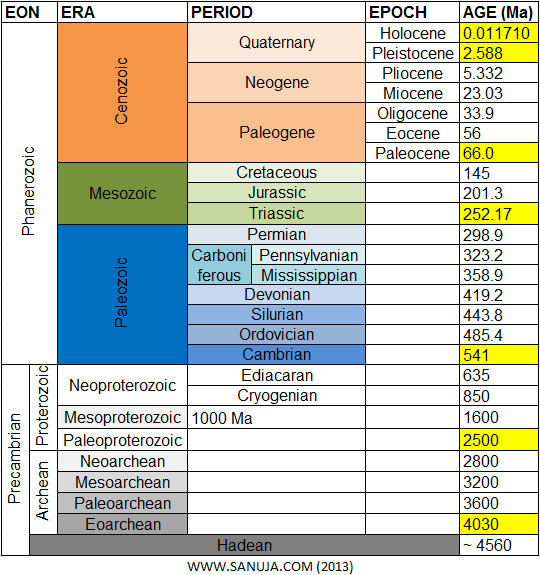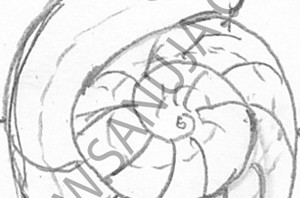Go to: Midterm II | Final
Since it is a 400-level class, I assume that you have the prior background in first (and second) year Geology classes. Note that I have separated all Protistans related questions into a separate exam database (second quiz).
Geology (GLGY 491-UCAL) Midterm I General
Congratulations - you have completed Geology (GLGY 491-UCAL) Midterm I General.
You scored %%SCORE%% out of %%TOTAL%%.
Your performance has been rated as %%RATING%%
Question 1 |
A | True |
B | False |
Question 2 |
A | True |
B | False |
Question 3 |
A | True |
B | False |
Question 4 |
A | False |
B | True |
Question 5 |
A | True |
B | False |
Question 6 |
A | Continuous genetic variability occurs in species with large morphological differences between sexes. |
B | Discontinuous genetic variability is less frequent than continuous genetic variability. |
C | Discontinuous genetic variability is more frequent than continuous genetic variability. |
D | Echinoids great are examples discontinuous genetic variability. |
Question 7 |
A | Assemblage Zones |
B | Interval Zones |
C | Morphological Zones |
D | Acme Zones |
Question 8 |
A | five |
B | two |
C | four |
D | three |
Question 9 |
- the frustule is composed of organic silica
- radial symmetry
- found in sediment samples throughout Jurassic to Holocene
- is a microfossil
This sample most like be a...
A | diatom. |
B | not enough data to distinguish. |
C | slilicoflagellate. |
D | coccolithophorid. |
E | tasmanitid. |
Question 10 |
A | young. |
B | mature. |
C | under development. |
D | old. |
Question 11 |
A | Recrystallization |
B | Impregnation |
C | Moldic fossilization |
D | Canonization |
Question 12 |
A | Archaeocytes |
B | Porocytes |
C | Amblyprocts |
D | Scierocytes |
Question 13 |
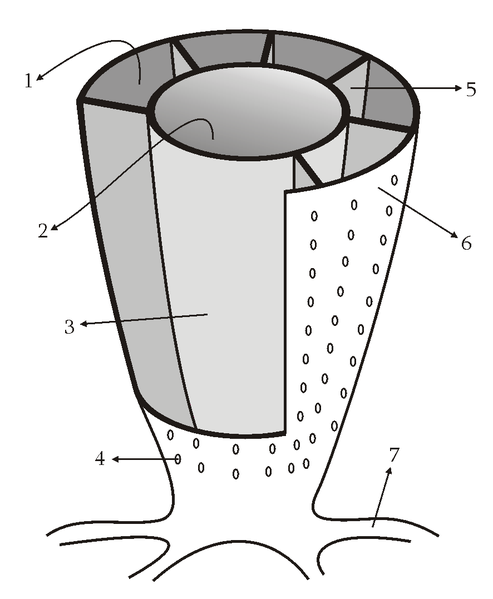
A | 1 |
B | 5 |
C | 2 |
D | 7 |
Question 14 |
A | Bilateral symmetry |
B | Biradial symmetry |
C | Radial symmetry |
D | Spherical symmetry |
Question 15 |
A | I. anisometric II. isometric |
B | I. symmetrical II. non-symmetrical |
C | I. isometric II. anisometric |
D | I. non-symmetrical II. symmetrical |
Question 16 |
A | False |
B | True |
Question 17 |
A | Carbonization |
B | Impregnation |
C | Congealment |
D | Impressions |
Question 18 |
A | Paleozoic |
B | Carboniferous |
C | Neogene |
D | Neoproterozoic |
Question 19 |
A | coprolites (poops). |
B | mammals. |
C | dinosaurs. |
D | insects. |
Question 20 |
What is 3L on the following diagram?
Note: DO NOT scroll down to the Geologic Time scale on this page. Answer this without using any AIDS.
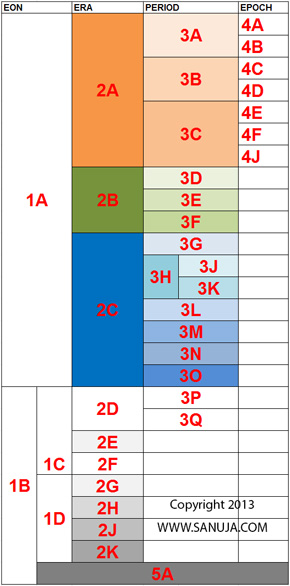
A | Pennsylvanian |
B | Jurassic |
C | Devonian |
D | Ordovician |
Question 21 |
A | SpongeBob SquarePants can NOT be classified into Phylum Proifera. |
B | They have well specialized organs. |
C | They are planktonic organisms. |
D | They lived attached to the substratum with the aid of root-like structures. |
Question 22 |
A | I. Permian II. Neogene |
B | I. Permian II. Devonian |
Question 23 |
On the following diagram, around what time 5A ended?
Note: DO NOT scroll down to the Geologic Time scale on this page. Answer this without using any AIDS.

A | 4030 Ma |
B | 252.17 Ma |
C | 4560 Ma |
D | 66.0 Ma |
Question 24 |
A | True |
B | False |
Question 25 |
A | 50,000 years |
B | 6000 years |
C | 8,000 years |
D | 11,700 years |
E | 22,000 years |
Question 26 |
A | Cretaceous - Paleogene |
B | Devonian - Silurian |
C | Devonian - Carboniferous |
D | Permian - Triassic |
E | Carboniferous - Permian |
Question 27 |
A | biocherms. |
B | reefs. |
C | ecologic. |
D | platonic. |
Question 28 |
A | platyproct |
B | stenoproct |
C | euryproct |
D | amblyproct |
Question 29 |
A | Genetic |
B | Chemical |
C | Morphological |
D | Stratigraphic |
Question 30 |
A | Genetic studies |
B | Morphological studies |
C | Chemical compositional studies |
D | Behavioral studies (trace fossils) |
Question 31 |
A | Fossils of the organism were found without the exoskeleton. Hint: Impossible due to soft body dissolution. |
B | Abundance in organic matter in some parts of the stratigraphic windows. |
C | The trace fossils left by the organism during certain growth periods. |
D | The lack of exoskeletons in some parts of the stratigraphic windows. |
Question 32 |
A | Morphological Trajectory |
B | Genetic Trajectory |
C | Nongenetic Trajectory |
D | Ontogeneric Trajectory |
Question 33 |
A | Cenozoic |
B | Precambrian |
C | Paleozoic |
D | Carboniferous |
E | Mesozoic |
Question 34 |
A | Improved Linnaean hierarchy |
B | Original Linnaean hierarchy |
C | Modern Linnaean hierarchy |
Question 35 |
A | Populations that naturally breed together and provide viable offspring. |
B | Diagnosable cluster within which there is a pattern of ancestry. |
C | Set of organisms with similar physical characteristics. |
D | Grouping of kingdoms which have the height precedence in taxonomy. |
Question 36 |
A | Miocence |
B | Quaternary Hint: This is the period and NOT the era. |
C | Holocene Hint: This is the Epoch and NOT the era. |
D | Cenozoic |
Question 37 |

A | Not enough information is given. |
B | Radial |
C | Pentameral |
D | Bilateral |
Question 38 |
-underwent rapid burial
-internal structures were often preserved
-most fossils from Ediacaran period were fossilized through this process.
A | Permineralization |
B | Impressions |
C | Carbonization |
D | Permineralization |
Question 39 |
A | taxonomy. |
B | taxa. |
C | biostratigraphy. |
D | evolutionary biology. |
Question 40 |
There are only two sub-Periods (subdivisions) on this diagram. They are represented by 3J and 3K. What are they?
Note: DO NOT scroll down to the Geologic Time scale on this page. Answer this without using any AIDS.

A | 3J - Mississippian 3K - Pennsylvanian |
B | 3J - Devonian 3K - Silurian |
C | 3J - Pennsylvanian 3K - Mississippian |
D | 3J - Silurian 3K - Devonian |
Question 41 |
A | Impregnation |
B | Moldic fossilization |
C | Fossilization in Amber |
D | Congealment |
Question 42 |
A | False |
B | True |
Question 43 |
A | PTD |
B | Acme Zone |
C | Evolutionary Occurrence |
D | LAD |
Question 44 |
A | echinoids. |
B | trilobite. |
C | bivalves. |
D | humans. |
Question 45 |
A | True |
B | False |
Question 46 |
A | 541 Ma |
B | 4560 Ma |
C | 2500 Ma |
D | 4030 Ma |
Question 47 |
A | Devonian |
B | Silurian |
C | Archean |
D | Permian |
Question 48 |
A | most abundant fossils |
B | identity fossil |
C | trace fossils |
D | index fossils |
E | characteristic fossil |
Question 49 |
A | Early middle Cambrian |
B | Lower Silurian |
C | Middle Ordovician |
D | Early Lower Permian |
Question 50 |
A | Jurassic |
B | Triassic |
C | Mississippian |
D | Devonian |
Question 51 |
A | Phylum Cnidaria |
B | Phylum Porifera |
C | Phylum Helmichordata |
D | Phylum Brachiopoda |
Question 52 |
A | Pentameral |
B | Circular |
C | Spherical |
D | Radial |
Question 53 |
A | 541 Ma |
B | 252.17 Ma |
C | 66.0 Ma |
D | 0.011710 Ma |
Question 54 |
A | Order |
B | Kingdom |
C | Superclass |
D | Phylum |
Question 55 |
A | pinacocytes |
B | archaeocytes |
C | sclerocytes |
D | choanocytes |
Question 56 |
A | Genus and Species |
B | Order and Family |
C | Phylum and Family |
D | Class and Species |
Question 57 |
A | 66 millions of years ago |
B | 13 millions of years ago |
C | 0.0117 millions of years ago |
D | 541 millions of years ago |
Question 58 |
A | test |
B | cells |
C | opaline silica |
D | frustule |
Question 59 |
A | The last appearance of an organism/group. |
B | The first appearance of an organism/group. |
C | Abundance of specific organisms in a given time window. |
D | Sudden fluctuation in morphological features of an organism/group. |
Question 60 |
A | True |
B | False |
Question 61 |
A | Accretion |
B | Modification |
C | Molting |
D | Addition |
Question 62 |
A | Lingula |
B | Inoceramus |
C | Pentremites |
D | Archaeocyathid |
Question 63 |
This particular Period is known for high volumes of coal formations. It is first appears on Geological records around 358.9 Ma. What is the Period and it's location on the following diagram?
Note: DO NOT scroll down to the Geologic Time scale on this page. Answer this without using any AIDS.

A | Carboniferous; 3B |
B | Carboniferous; 3H |
C | Jurassic; 3E |
D | Jurassic; 3D |
Question 64 |
A | classes |
B | orders |
C | phyla |
D | families |
E | genera |
Question 65 |
A | two |
B | infinite |
C | three |
D | one |
Question 66 |
Choose the odd one out based on the process of fossilization. (Choose the best option!)
InsectsDiatoms
Bivalves
Coccolithophorids
Sponges
Gastropods
A | Gastropods |
B | Diatoms |
C | Bivalves |
D | Insects |
Question 67 |
A | Cretaceous to Neogene |
B | Ordovician to Permian |
C | Cambrian to Mississippian |
D | Ordovician-Devonian |
Question 68 |
A | Class Demospongea |
B | Class Calcarea |
C | Class Germaphobia |
D | Class Hexactinellida |
Question 69 |
On the following diagram, what is highlighted in 3C?
Note: DO NOT scroll down to the Geologic Time scale on this page. Answer this without using any AIDS.

A | Cretaceous |
B | Quaternary |
C | Permian |
D | Paleogene |
Question 70 |
What are the Eons represented by 1A and 1B respectively on the following diagram?
Note: DO NOT scroll down to the Geologic Time scale on this page. Answer this without using any AIDS.

A | Phanerozoic and Precambrian |
B | Proterozoic and Archean |
C | Cenozoic and Mesozoic |
D | Cenozoic and Paleozoic |
Question 71 |
A | Choanocytes |
B | Sclerocytes |
C | Archaeocytes |
D | Pinacocytes |
Question 72 |
A | Suborder |
B | Subtribe |
C | Subspecies |
D | Tribe |
E | Subfamily |
Question 73 |
A | Cretaceous |
B | Eoarchean |
C | Holocene |
D | Ediacaran |
Question 74 |
On the following diagram, what is highlighted in 2D?
Note: DO NOT scroll down to the Geologic Time scale on this page. Answer this without using any AIDS.

A | Neoproterozoic |
B | Ediacaran |
C | Devonian |
D | Cretaceous |
E | Ordovician |
Question 75 |
A | False |
B | True |
Question 76 |
A | True |
B | False |
Question 77 |

A | basal ring |
B | central cavity |
C | feet |
D | holdfast |
Question 78 |

A | Ammonite |
B | Brachiopod |
C | Cruziana |
D | Trilobite |
Question 79 |
A | genetic structures |
B | growth stages. |
C | living environments |
D | genetic variation |
Question 80 |
A | True |
B | False |
Question 81 |
A | Molting |
B | Addition |
C | Accretion |
D | Modification |
Question 82 |
A | Rhagon |
B | Leucon |
C | Ascon |
D | Hyperdemia |
E | Sycon |
Question 83 |
A | differentiation between growth stages. |
B | ecological conditions. |
C | sexual dimorphism. |
D | sudden changes in genetic variation. |
Question 84 |
A | Cristata |
B | Hexagonaria |
C | Cnidaria |
D | Animalia |
Question 85 |
A | False |
B | True |
← |
List |
→ |
| 1 | 2 | 3 | 4 | 5 |
| 6 | 7 | 8 | 9 | 10 |
| 11 | 12 | 13 | 14 | 15 |
| 16 | 17 | 18 | 19 | 20 |
| 21 | 22 | 23 | 24 | 25 |
| 26 | 27 | 28 | 29 | 30 |
| 31 | 32 | 33 | 34 | 35 |
| 36 | 37 | 38 | 39 | 40 |
| 41 | 42 | 43 | 44 | 45 |
| 46 | 47 | 48 | 49 | 50 |
| 51 | 52 | 53 | 54 | 55 |
| 56 | 57 | 58 | 59 | 60 |
| 61 | 62 | 63 | 64 | 65 |
| 66 | 67 | 68 | 69 | 70 |
| 71 | 72 | 73 | 74 | 75 |
| 76 | 77 | 78 | 79 | 80 |
| 81 | 82 | 83 | 84 | 85 |
| End |
You may download this exam as a PDF file here.
Geology (GLGY 491-UCAL) Midterm I Protistans
Congratulations - you have completed Geology (GLGY 491-UCAL) Midterm I Protistans.
You scored %%SCORE%% out of %%TOTAL%%.
Your performance has been rated as %%RATING%%
Question 1 |
A | Jurassic to Holocene (recent) |
B | Paleozoic to Holocene (recent) |
C | Cretaceous to Holocene (recent) |
D | Cambrian to Miocene |
Question 2 |
A | True |
B | False |
Question 3 |
A | Upper Devonian |
B | Lower Jurassic |
C | Upper Silurian |
D | Middle Cambrian |
Question 4 |
A | True |
B | False |
Question 5 |
A | radial |
B | bilateral |
C | no symmetry; primitive. |
D | co-axial |
Question 6 |
A | Silicoflagellates |
B | Radiolarians |
C | Diatoms |
D | Tasmanitids |
Question 7 |
A | cortical spines |
B | byspines |
C | polar spines |
D | central spines |
Question 8 |
A | Charles Robert Darwin |
B | Joseph Dalton Hooker |
C | Ernst Haeckel |
D | Dr. Marius (Dan) Georgescu |
Question 9 |
A | False because it is the abundance of oxygen and light. |
B | False because the availability of other micro-organisms for food supply that dictates the distribution. |
C | False because it is the temperature of the upper water column. |
D | True |
Question 10 |
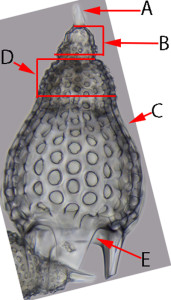
A | Basal ring |
B | Cephalon |
C | Sagittal ring |
D | Aperture |
Question 11 |

A | basal ring |
B | cortical shell |
C | microsphere |
D | medullar shell |
Question 12 |
A | Apical ring |
B | Basal ring |
C | Spines (larger) |
D | Bars |
Question 13 |
A | Diatoms |
B | None; all of them have plant-like metabolism |
C | Silicoflagellates |
D | Foraminifera |
Question 14 |
A | clay |
B | chalks and calcareous oozes |
C | oil shales |
D | inorganic reefs |
Question 15 |
A | True |
B | False |
Question 16 |
A | Oxygen |
B | Nitrogen |
C | Carbon |
D | Silicon |
Question 17 |
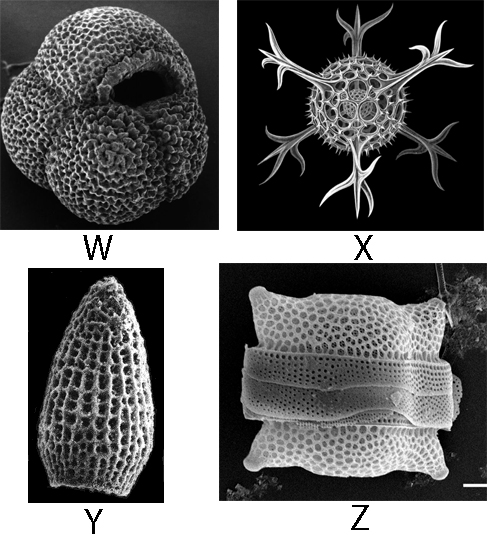
A | X |
B | W |
C | Z |
D | Y |
Question 18 |
A | Profiera |
B | Coccolithophorids |
C | Archaeocyatha |
D | Diatoms |
Question 19 |
A | True |
B | False |
Question 20 |
A | Apical ring |
B | Basal ring |
C | Spines |
D | Bars |
Question 21 |
A | False |
B | True |
Question 22 |
Find the odd one out.
SilicoflagellatesDiatoms
Radiolarians
Coccolithophorids
Sponges
Foraminifera
A | Radiolarian |
B | Sponges |
C | Coccolithophorids |
D | Silicoflagellates |
Question 23 |
A | Holocene |
B | Ordovician |
C | Late Triassic |
D | Ediacaran |
Question 24 |

A | cortical shell |
B | microsphere |
C | medullar shell |
D | basal ring |
Question 25 |
A | 1000 - 5000 microns. |
B | 50 - 900 microns. |
C | 300 - 900 microns. |
D | 20 - 200 microns. |
Question 26 |
A | They have animal-type metabolism. |
B | They started to dissolve well above the CCD of the water column. |
C | They are closely related to Radiolarians. |
D | They started to dissolve well below the CCD of the water column. |
E | They are typically benthic form of organisms. |
Question 27 |
A | Passive; like people high on weed. |
B | At young stage, passive. At adult stage active. |
C | Active |
D | At young stage, active. At adult stage passive. |
Question 28 |

A | Cephalon |
B | Abdomen |
C | Aperture |
D | Thorax |
Question 29 |

A | Thorax |
B | Aperture |
C | Abdomen |
D | Cephalon |
Question 30 |
A | True |
B | False |
Question 31 |
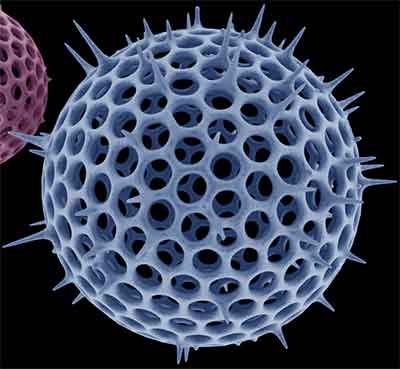
A | Forminifera |
B | Spumellaria |
C | Coccolithophorids |
D | Nassellaria |
Question 32 |
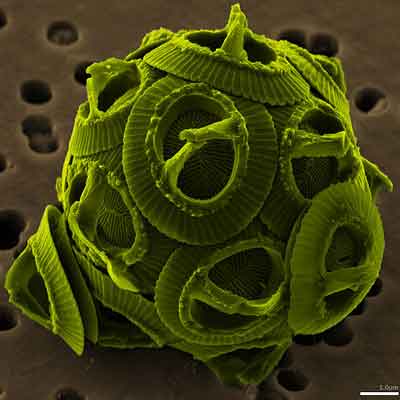
A | Forminifera |
B | Spumellaria |
C | Diatom |
D | Coccolithophorids |
Question 33 |
A | True |
B | False; it is six bars. |
C | False; it is four bars. |
Question 34 |
A | organic reefs and clastic rocks |
B | in organic shale |
C | coccolithoids |
D | chalks and calcareous oozes |
Question 35 |
A | Spumellaria |
B | Foraminifera |
C | Albaillaria |
D | Sponges |
Question 36 |

A | X |
B | W |
C | Z |
D | Y |
Question 37 |
A | Ediacaran to Cretaceous |
B | Jurassic to Holocene (recent) |
C | Jurassic to Cretaceous |
D | Cambrian to Holocene (recent) |
Question 38 |
A | Epitheca |
B | Hypotheca |
C | Epicingulum |
D | Epiproferia |
Question 39 |
A | Diatoms |
B | Tasmanitids |
C | Silicoflagellates |
D | Nassellaria |
Question 40 |
A | Anything above 10% |
B | Anything above 5% |
C | Anything above 40% |
D | Anything above 1% |
Question 41 |
Find the odd one out.
SilicoflagellatesDiatoms
Radiolarians
Coccolithophorids
Tasmanitids
A | Silicoflagellates |
B | Tasmanitids |
C | Coccolithophorids |
D | Diatoms |
E | Radiolarians |
Question 42 |
A | Hypotheca |
B | Epiproferia |
C | Epicingulum |
D | Epitheca |
Question 43 |

A | Outer most part in green. |
B | Black lines indicating the spines. |
C | Middle part in red. |
D | Central part in blue. |
Question 44 |
A | Lower Cretaceous |
B | Upper Cambrian |
C | Upper Devonian |
D | Middle Jurassic |
← |
List |
→ |
| 1 | 2 | 3 | 4 | 5 |
| 6 | 7 | 8 | 9 | 10 |
| 11 | 12 | 13 | 14 | 15 |
| 16 | 17 | 18 | 19 | 20 |
| 21 | 22 | 23 | 24 | 25 |
| 26 | 27 | 28 | 29 | 30 |
| 31 | 32 | 33 | 34 | 35 |
| 36 | 37 | 38 | 39 | 40 |
| 41 | 42 | 43 | 44 | End |
You may download this exam as a PDF file here.
Credits: Based on the excellent class notes provided by, Dr. Marius (Dan) Georgescu during Fall 2013.
FAQ | Report an Error
Hierarchy of Life
- Kingdom
- Phylum
- Class
- Order
- Family
- Genus
- Species
Click here for specific biological taxonomical divisions.
Geologic Time Scale
Mobile Users: Best view in landscape mode when mobile version is active.
| EON | ERA | PERIOD | EPOCH | AGE (Ma) | ||
-zoic |
Cenozoic (Cz) |
Quaternary (Q) | Holocene | 0.011710 | ||
| Pleistocene (Ps) | 2.588 | |||||
| Neogene (N) | Pliocene (PO) | 5.332 | ||||
| Miocene (MI) | 23.03 | |||||
| Paleogene (PE) | Oligocene(OG) | 33.9 | ||||
| Eocene (EO) | 56 | |||||
| Paleocene (Pε) | 66.0 | |||||
| Mesozoic (MZ) |
Cretaceous (K) | 145 | ||||
| Jurassic (J) | 201.3 | |||||
| Triassic (Tr) | 252.17 | |||||
| Paleozoic (Pz) |
Permian (P) | 298.9 | ||||
| Carboni- -ferous (C) |
Pennsylvanian (|P) | 323.2 | ||||
| Mississippian (M) | 358.9 | |||||
| Devonian (D) | 419.2 | |||||
| Silurian (S) | 443.8 | |||||
| Ordovician (O) | 485.4 | |||||
| Cambrian (∈) | 541 | |||||
| Pre∈ | Pro- -terozoic (Ρ) |
Neo (Z) | 635 | |||
| 850 | ||||||
| Meso (Y) | 1000 Ma | 1600 | ||||
| Paleo (X) | 2500 | |||||
| Archean (A) | 2800 | |||||
| 3200 | ||||||
| 3600 | ||||||
| 4030 | ||||||
| Hadean (ρA) | ~ 4560 | |||||
* Symbols are based on reference USGS reference table.
Image version of the above table for those who are still using stone age computers like Fred Flintstone.
